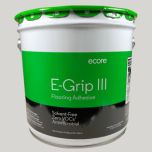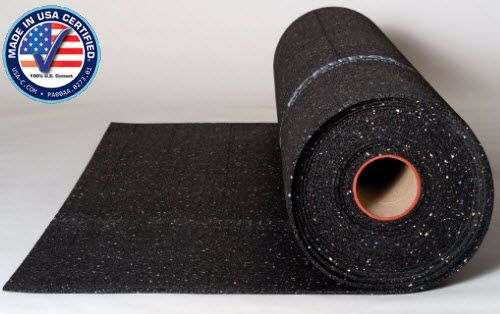Ecore QTscu 4003 (Sound Control Underlayment)
Created in 2000, QTscu is the original and leading recycled rubber underlayment.
QT sound control underlayments are designed to reduce impact noise in the floor ceiling assembly. QT, the most tested sound control underlayment, is crush resistant, durable and high acoustic performance under wood, tile and other hard surfaces. QT is also provide a high sound control performance in floating method of installation, for floating of hardwood floors and floating of laminated floors. QT is approved by sound engineers and will exceed HOA acousti control requirements. QT4002 is 2mm, QT4003 is 3mm, QT4005 is 5mm, QT4010 is 10mm, QT4012 is 12mm & QT5015 is 15mm. Perimeter Isolation Strip is available in 6mm only.
| Ecore QTscu 4005 (5mm QT Sound Control Underlayment) performs better than ½” Cork per ASTM E2179 |
How to order:(Sold by full Roll)
Enter Qty/SF (160 SF/Roll)
QT Acoustic Insulation & QT Sound Control Underlayment
Recommended by Acoustic Engineers
QTscu (Sound Control Underlayment) or QT Sound Insulation is a flat, resilient rubber underlayment made from a formulation of high quality post consumer recycled rubber granules encapsulated in a wear and water resistant elastomeric network with multiple colored reprocessed ColorMill EPDM rubber. Qt is used directly under most floor finishes, yielding exceptional results even under hard surface flooring and over concrete and wood joist construction.
QTscu is available in 48” wide rolls and five standard thicknesses, 2mm, 5mm 10mm, 12mm and 15mm. Also available with a waterproof membrane, QTscu rubber underlayment can be installed under most types of grouted, glued and floating floors including ceramic tile, natural stone, marble, brick, pavers, hardwood, engineered wood, laminate floor, parquet flooring, sheet vinyl, vinyl tile, LVT and carpet. QT sound control underlayment is made from 92% resilient recycled rubber and backed by over 400 independent laboratory and field tests, QTscu has been recommended and approved by Home Owner Association and used in some of the luxury condominiums all around the world. QT is a preferred product for superior sound insulation in commercial and residential projects.
The QTscu line of products for impact sound insulation is engineered to provide better performance than any other sound control product available, and has been rigorously tested to achieve proven results. Made from 92% resilient recycled rubber and backed by over 400 independent laboratory and field tests, QT has been selected and used in some of the best hotels and condominiums in the world. It can be installed under most types of grouted, glued, and floating floors including ceramic tile, stone, marble, brick, pavers, hardwood, engineered wood, laminate, parquet, sheet vinyl, LVT and carpet. All floor covering assemblies shall have prior approval before installation.
LEED Credit:
QT Sound Insulation is designed to meet the stringent criteria required to help earn points under 2 of the 6 categories of LEED. Based on these criteria, QT products can assist specifiers by potentially contributing toward earning up to 7 LEED points in new construction and commercial interiors and 9 LEED points in existing buildings.
What is IIC and STC?
IIC: Impact Insulation Class
STC: Sound Transmission Class
Sound insulation between living areas in multi-family or single-family dwellings, is an important issue for the floor covering industry. When evaluating flooring underlayment for sound deadening characteristics; acoustical consultants, architects/specifiers and others rely on sound testing to define the performance of a floor/ceiling assemblies and determine how well they insulate against noise created by impact and by airborne vibration. The testing methods utilized in North America for sound evaluations and comparisons, and the values they generate, can be somewhat confusing and even, perhaps, misleading. The following is an effort to explain those sound test methods and their results.
There are two types of laboratory sound tests performed in a controlled environment recognized by the International Building Code (IBC) for sound vibration that travels from one living area to another: Impact Insulation Class (IIC) and Sound Transmission Class (STC). IIC tests the ability to block impact sound by measuring the resistance to transmission of impact noise or structure-borne noise (simulating footfalls, objects dropped on the floor, etc.). STC evaluates the ability of a specific construction assembly to reduce airborne sounds, such as voices, stereo systems, and TV. Both tests involve a standardized noise making apparatus in an upper chamber and a sound measuring system in a lower chamber. Decibel measurements are taken at various specified frequencies in the lower chamber. Those readings are then combined using a mathematical formula to create a whole number representation of the test, the higher the number, the higher the resistance. Ratings of 50 or above for both the IIC and STC sound tests will satisfy the minimum requirements of the International Building Code. Non-laboratory, “field” tests for impact sound (FIIC) and for airborne sound (FSTC) are also recognized by the International Building Code. These sound tests utilize the same testing methods as IIC and STC but are conducted in an actual building after the floor installation is completed.
The IBC suggests ratings of 45 or higher for FIIC and FSTC testing. With the various types and combinations of building materials available to the industry, it is not surprising that the sound test results among different floor/ceiling assemblies may vary dramatically. One can imagine sound testing over a 6” concrete floor with a 12” suspended ceiling attached and filled with 8” of fiberglass insulation, as apposed to testing over just a 6” concrete slab. The more layers and thickness of materials usually means a higher sound test result. It is important to note that IIC/FIIC and STC/FSTC tests are not single component tests, but an evaluation of the whole floor/ceiling assembly, from the surface of the floor covering material in the upper unit, to the ceiling in the lower unit. An integral part of a report for any of these sound tests is a detailed description of the floor/ceiling assembly used in the test. IIC/FIIC and STC/FSTC tests are essential tools for evaluating sound in multi-level dwellings. However, without knowing and accounting for the whole floor/ceiling structure used in the test, the results are basically meaningless. Using IIC (FIIC) and STC (FSTC) results to represent the sound deadening ability of an underlayment without describing, in detail, the whole floor/ceiling assembly causes confusion at all levels of the marketplace and is ultimately misleading to the consumer.
The only way to accurately compare the sound deadening characteristics among underlayment materials using IIC/FIIC and STC/FSTC testing is to keep all other components in the test assembly constant, i.e., the same floor covering material, the same thickness and density of concrete (or composition of wood sub-floor), and the same suspended ceiling assembly. With everything else being equal, one can evaluate different underlayment as to their individual contributions to the sound insulating ability of that whole floor/ceiling structure. Another test that more directly evaluates impact sound of underlayment materials is ASTM E-2179, also known as the “Delta” test. This test basically consists of two IIC tests conducted over the same concrete sub-floor (150mm ± 50mm thick). One test is over the bare concrete subfloor (no flooring materials) and the other is over the concrete sub-floor with floor covering material and underlayment included. The measured IIC values are compared to the reference floor levels defined in the standard and adjusted to provide the IIC the covering would produce on the reference concrete floor. The Delta IIC or improvement of impact sound insulation is obtained by subtracting 28 (the value for the reference bare floor from the standard) from the adjusted IIC of the whole assembly. As long as the same floor covering material is used, one can conduct a series of Delta tests to evaluate among various underlayment materials.
For sound traveling from an upper living area to a lower living area, IIC/FIIC and STC/FSTC testing methods are important for evaluating whole floor/ceiling assemblies. For the accurate evaluation and comparison of the sound isolation characteristics of underlayment materials, the appropriate methods to use are either: 1) the ASTM E-2179 Delta test or 2) IIC/FIIC and/or STC/FSTC tests where the only variable in the floor/ceiling assembly is the underlayment material.
The most tested Sound Control product in the industry!
QT Sound Insulation is a line of high quality sound control underlayment, manufactured in the U.S.A. by Ecore International, a leading innovator in recycled products technology. QT is made from 92% recycled rubber and has been tested in over 200 different laboratory and field test assemblies. Ideal for multi-family housing, high rises, single family homes and office buildings, QT holds a lifetime warranty against product defects and workmanship. QT products have been engineered to meet design requirements and all established indoor air quality standards and building codes. The product and engineering support that is provided by QT guarantees that QT will work as specified every time.
Note:
E-Grip III Adhesive is manufacture's recommended adhesive for QT SCU products.
*QT Perimeter Isolation Strip is available in 6mm Thick x 2.5 Inch x 50 LF.
QT Basic Installation Overview
QT Technical Manual - Installation & Warranty
Supported by more than 650 independent Lab/Field Tests & an Acoustical Engineer; QTscu is applicable for a wide range of flooring types.
| Manufacturer / Supplier | ECORE International |
|---|---|
| Collection | QTscu Sound Control Underlayment |
| Style Name | QTscu 4003 |
| Country of Origin | USA |
| Construction | Solid Rubber |
| Face | Flat |
| Contents | 92% Resilient Recycled Rubber |
| Available Shapes | Roll only |
| Width | 4 Feet (48") |
| Length | 40 Feet |
| Thickness | 3mm |
| Material Weight | QT4002: 120 lb/Roll, QT4003: 85 lb/Roll, QT4005: 100 lb/Roll, QT4010: 100 lb/Roll, QT4012: 120 lb/Roll & QT5015: 135 lb/Roll |
| Installation Method | Direct Glue-down or Float |
| Where to Install | Below, On or Above Ground Level |
| Sq. Ft. / Roll | 160 SF |
| Freight to CFM | $250.00 |
| Freight to Customer | Please call (310) 481-0611 for Freight Charge |
-
 Ecore QTscu 4012 (Sound Control Underlayment)Regular Price $2.29 Special Price $1.99
Ecore QTscu 4012 (Sound Control Underlayment)Regular Price $2.29 Special Price $1.99 -
 Ecore QTscu 4010 (Sound Control Underlayment)Regular Price $1.99 Special Price $1.69
Ecore QTscu 4010 (Sound Control Underlayment)Regular Price $1.99 Special Price $1.69 -
 Ecore QTscu 4005 (Sound Control Underlayment)Regular Price $0.99 Special Price $0.90
Ecore QTscu 4005 (Sound Control Underlayment)Regular Price $0.99 Special Price $0.90 -
 E-Grip III Adhesive$249.00
E-Grip III Adhesive$249.00





